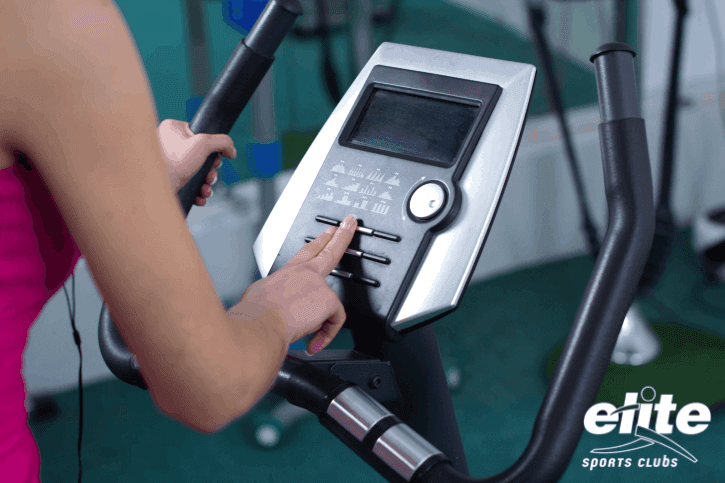
Watts. It is that number that you often see scroll across your display on the exercise bike or elliptical. It changes all the time, and you might not realize what you are doing or not doing to make it change. But what does that number even mean, and is it important to your workout?
Watts is a measurement of the power you are producing. It is how much energy is needed to overcome inertia and make things go, like pedaling your bike, climbing stairs, powering the elliptical or even running on a treadmill. Simply speaking, the more power you are producing, the harder you are working.
So, should you be more involved with this number, or can you do without? The answer depends on your desired outcome. You could also get a performance enhancing and weight loss workout using other methods such as heart rate training, but following your watts could give you an edge. Observing your watts gives you immediate and quantifiable feedback regarding the intensity of your workout. Heart rates can be affected by outside factors such as fatigue, sleep, hydration, and illness. Watts is a real-time value, not influenced by outside factors.
Using watts is another way to evaluate the intensity of your workout. By maintaining or setting the machine to operate a specific watt load, you can work at a consistent level of intensity. You could also use the watts feature to determine your caloric burn for a period of time, if weight loss is your goal. Simplified, without a long physics lesson, we can use the following formula:
Energy (kCal or calories) = Av Power (Watts) x Duration (hours) x 3.6
Knowing this, setting your machine for a specific workload or watts for a specific period of time, you can expect to burn a specified number of calories during that time of exercise.
Athletes often train using watts, training their bodies to create power to achieve optimal results. Cyclists and rowers specifically have used watt training to enhance their fitness and improve their performance. Knowing a specific value of power, workouts can be performed to improve upon their watts, much like one would train off a program designed to improve cardiovascular function based on heart rate.

Setting your correct watt value may seem challenging or confusing, but Elite Sports Clubs’ West Brookfield and North Shore locations can help make your experience with watts an exciting one. With the introduction of the Matrix iC7 indoor cycle bikes, all members can use watt training during cycle classes. Often times, watts training on a bike is thought to be reserved for “serious” riders or elite cyclists, but Elite can deliver the same experience in their regular scheduled cycle classes, taking your workout to the next level. Whether you take class for general fitness, weight loss, or a personal challenge, everyone can use watts, and use them effectively!
Set up a Free Fitness ConsultationWritten by Melissa Radmer, CPT, Group Exercise & Fitness Director at Elite Sports Club-West Brookfield
9 Comments
For a female ice hockey elite player, Is 908 Watts good on a stationary bike? Can it be harmful?
I am 79 years young and have been training on an indoor exercise bike 6 to 7 hours a week. I have been a distance runner for 50 years; however, due to spinal degeneration, I’ve been training exclusively on my exercise bike over the last 4 months. I train to simulate running by way of monitoring my heartrate and power (120-135 power) for 60-90minutes. I like the indoor cycling very much, BUT, I miss the running. I maintain a resting HR of 146 avg.
I am a 63 year old stroke survivor doing fitness training. My lasreport saiid my av max was 18 compared with11 3 months ago my watts were 139wattsI had to stop the test at 7 minutes 26 seconds exhaustion. Is this good .? They tell me it’s a 64% fitness improvement
I’m 60 doing 100 watts average (cardio setting) for 30 minutes on the Arc trainer 3 times a week and I’m done (fatigued).
The coaching sites I read estimate that untrained, young adult males can produce 1 watt per pound of body weight for one hour in an all-out effort. A very fit amateur bike racer typically produces 1.8 watts per pound (easier when you’re that skinny). For females and older adults the watts drop off, but this estimate gives gym members a range they can plug their goals into.
This helped me identify a heart condition – my heart rate was jumping without an increase in watts – in other words, my heart wasn’t racing because I was working harder!
Both bpm and watts are important to monitor. For me, this was a potential life saver.
Does age have any bearing on how many watts you should work at.
I am 75 and average about 150 during 45 minutes bike trainer
What is the lowest amount of watts you should maintain for a good cardiovascular workout
Good question Steve! It is a bit hard to answer though. The more aerobically fit you are, the higher the watts you can sustain for extended periods. It’s like saying level 8 is a good place on the elliptical, but might be too hard for a beginner, and too fluffy for someone that is aerobically fit.
I would suggest 50 – 100 watts as a beginner, and 100-150 as an intermediate.
Remember watts are force x speed——so on a bike, pedalling at a slow speed and high resistance will feel different than the same watts at faster speed and lower resistance, so it’s finding the balance on those two factors, then choosing one of them to alter to increase or decrease the watts or power output! ~Melissa